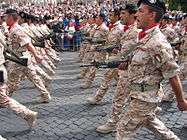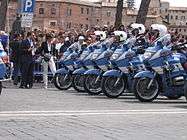Festa della Repubblica ([ˈfɛsta della reˈpubblika]; in English, Republic Day) is the Italian National Day and Republic Day, which is celebrated on 2 June each year. The day commemorates the institutional referendum held by universal suffrage in 1946, in which the Italian people were called to the polls to decide on the form of government, following the Second World War and the fall of Fascism. With 12,717,923 votes for a republic and 10,719,284 for the monarchy, the male descendants of the House of Savoy were sent into exile. To commemorate it, a grand military parade is held in central Rome, presided over by the President of the Italian Republic in his role as Supreme Commander of the Armed Forces. The Prime Minister, formally known as the President of the Council of Ministers, and other high officers of state also attend. There are important celebrations in all the Italian embassies and foreign heads of state are invited. Even though the main parade is in Rome, many Italian cities celebrate the day as well.[1]
Prior to the foundation of the Republic, the Italian national day was the first Sunday in June, anniversary of the granting of the Statuto Albertino. From 1977 to 1999, due to economic reasons, this was the date of the celebrations for the 1946 foundation of the republic. The 2 June date became official in 2000. The parade was held in Turin in 1961 to mark the centennial year of Italian unification.
The parade
In 1948, Via dei Fori Imperiali hosted the first military parade in honor of the new Italian Republic. The following year, with Italy's entry into NATO, ten were held simultaneously across the country and in 1950, the parade was featured for the first time in the protocol of official celebrations. This provides for the ceremonial laying of a wreath on the Tomb of the Unknown Soldier at the Vittoriano, before the President of Italy reviews the parading formations. The ceremony continues in the afternoon with the opening of the gardens of the Quirinale Palace, seat of the President of the Republic and with musical performances by the band ensembles of the Italian Army, Italian Navy, Italian Air Force, the "Arma dei Carabinieri", State Police, the "Guardia di Finanza", the Penitentiary Police Corps, State Firefighters Corps and the State Forestry Corps, together with the band of the Rome City Police.[2] The parade itself was cancelled thrice (in 1963, 1976 and 1992 at the last minute, and was moved to November 4, Armed Forces Day, only in 1964).
The parade begins when the Corazzieri Squadron of the Carabinieri arrives, either mounted or dismounted, at the Presidential grandstand at the Via dei Fori Imperiali with the President of Italy, and the honors are paid via the Italian Army Band or the mounted band of the 4th Carabineri Cavalry Regiment playing the first stanza of Il Canto degli Italiani, after which the squadron departs. The parade proper itself then starts with the Carabinieri Central Band striking up to "La Fedelissima", its official march, leading the parade proper with the parade commander, his staff and escort, followed by the National Colors of the Italian Armed Forces, standards of the regions of Italy and veterans associations. Following them are company-sized formations of Italian Armed Forces units, military bands and members of the Red Cross, Polizia di Stato, the Penitentiary Police Corps, State Firefighters Corps and the State Forestry Corps, and ending with the Rome City Police and the featuring the unique Bersaglieri contingent in their jogging pace. 2015 saw the debut appearances in the parade by government employees and the National Civil Defense Service.
Important years of the anniversary of both the Republic and the Unification of Italy have also seen mobile and air columns go past the tribune. The parade ends with a flyby of the Frecce Tricolori aerobactic team in the colors of the Flag of Italy.
See also
References















